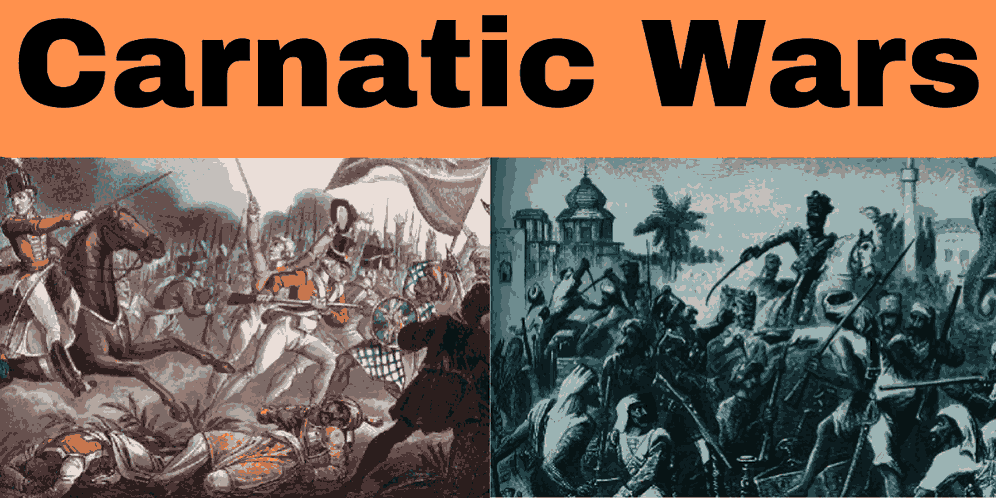Carnatic Wars
Introduction:
The Carnatic Wars were a series of military battles between the British East India Company and the French East India Company in the 18th century, with local monarchs also taking part. These conflicts were mostly focused on the Karnataka region of South India, hence the name.
The Carnatic Wars were part of a larger geopolitical conflict between European nations for domination in India known as the Anglo-French rivalry. These conflicts had far-reaching consequences for bfor British colonial dominance in the subcontinent.
Anglo-French Rivalry:
Carnatic Wars The British fought three successive wars with the French between 1746 and 1763 to establish their supremacy.These wars are called the Carnatic War by historians.
First Carnatic War :
- The war of succession in Europe also made it dominant in India, with King Charles VI of Austria dying in 1740.
- Bavaria, Saxony, and Spain united against Maria Teresa to succeed Charles .
- Taking advantage of this situation, King Frederick II of Prussia conquered Celia, a part of Austria.
- England opposed France because of this problem and as a result wars broke out between the two colonies in India.
- Nana, the head of Burnett, captured French ships carrying Indian goods on the English coast.
- As a result, the Governor of Puducherry Tuipley. He sought the help of the Nawab of Carnatic.
- Meanwhile, Dupleix contacted La Portonall, who was the governor of the island of France, who entered the Indian Ocean with eight of his warships.
- Biden, who was leaderless to the English observant, blocked the French ships with his four ships.
- Biden lost the battle on July 6, 1746.
Second Carnatic War:
- The Anglo-French rivalry in India paved the way for the Second Carnatic War.The death of Nizam-ul-Mulk in 1748 triggered a power struggle, with British and French rivals vying for power.
- Dupleix, the French governor, tried to increase French power in south India by interfering in local conflicts.
- The death of Nizam-ul-Mulk, the contended successor in Hyderabad and Karnataka, started the war.
- Muzaffar Jang and Chanda Sahib challenged Nasir Jung and Anwar-ud-din, who were supported by the French and supported by the British .
- Chanda Sahib opposed the appointment of Anwar-ud-din as the Nawab of Carnatic, which provoked hostility.Muzaffar Jung, Chanda Sahib and French forces defeated and killed Anwar-ud-din in the Battle of Ambur in 1749.
- Muhammad Ali succeeded his father as the Nawab of Carnatic.Muzaffar Jang was established as the Nizam, but the French brought in Salabat Jung in his place .
- Robert Clive Trichinopoly started a diversion experiment in Arcot to reduce the pressure, while Muhammad Ali hanged Chanda Sahib.
- Instead of ruling independently, Muhammad Ali and Salabat Jung became British and French clients, respectively.
Third Carnatic War:
- The Third Carnatic War was fought with the opposing forces of Britain and France during the Great War of the Seven Years‘ War (1756–1763) in Europe.
- In 1758, the French, under General Count Thomas Arthur de Lally, captured the British forts at St. David and Vijayanagara. However, the British severely damaged the French fleet under Admiral D ‘Auchi at Masulipatnam.
- The decisive battle of the Third Carnatic War was fought on 22 January 1760 at Vandiwash (or Vandavasi) in Tamil Nadu.English General Eyre Coote scored a major victory, defeating the French army under Count de Lally and capturing the Marquis de Bussy.
- Following the Battle of Carriagewash, Lally fought valiantly for eight months before surrendering Pondicherry on 16 January 1761, which dealt a severe blow to French power in India.
- The Treaty of Paris (1763) ended the conflict by returning Pondicherry and Chandannagar to France, while limiting their activities to trade. France’s political influence in India waned, leaving the British as a major European power in the subcontinent .
The factors that contributed to the British victory and the French defeat were:
- The English East India Company was a private company, allowing for faster decision-making and greater freedom than the state-controlled French company.
- The superiority of the British navy prevented important sea routes for the French, and the British captured major cities such as Calcutta, Bombay, and Madras, while the French controlled only Pondicherry.
- The British prioritized commercial interests and had more financial resources than the French.
- Superior British Generals: The British had able leaders such as Eyre Coote, Stringer Lawrence and Robert Clive, while the French had no such leadership.
- The success of Vandiwash cemented British power in India, opening the way for future expansion and colonial rule.
- During the Third Carnatic War, natives served in both armies, revealing the complexity of Indian colonial wars.
- The conflict was a pivotal moment in the struggle for control in India, resulting in British rule in the region.



Pingback: Hyder Ali